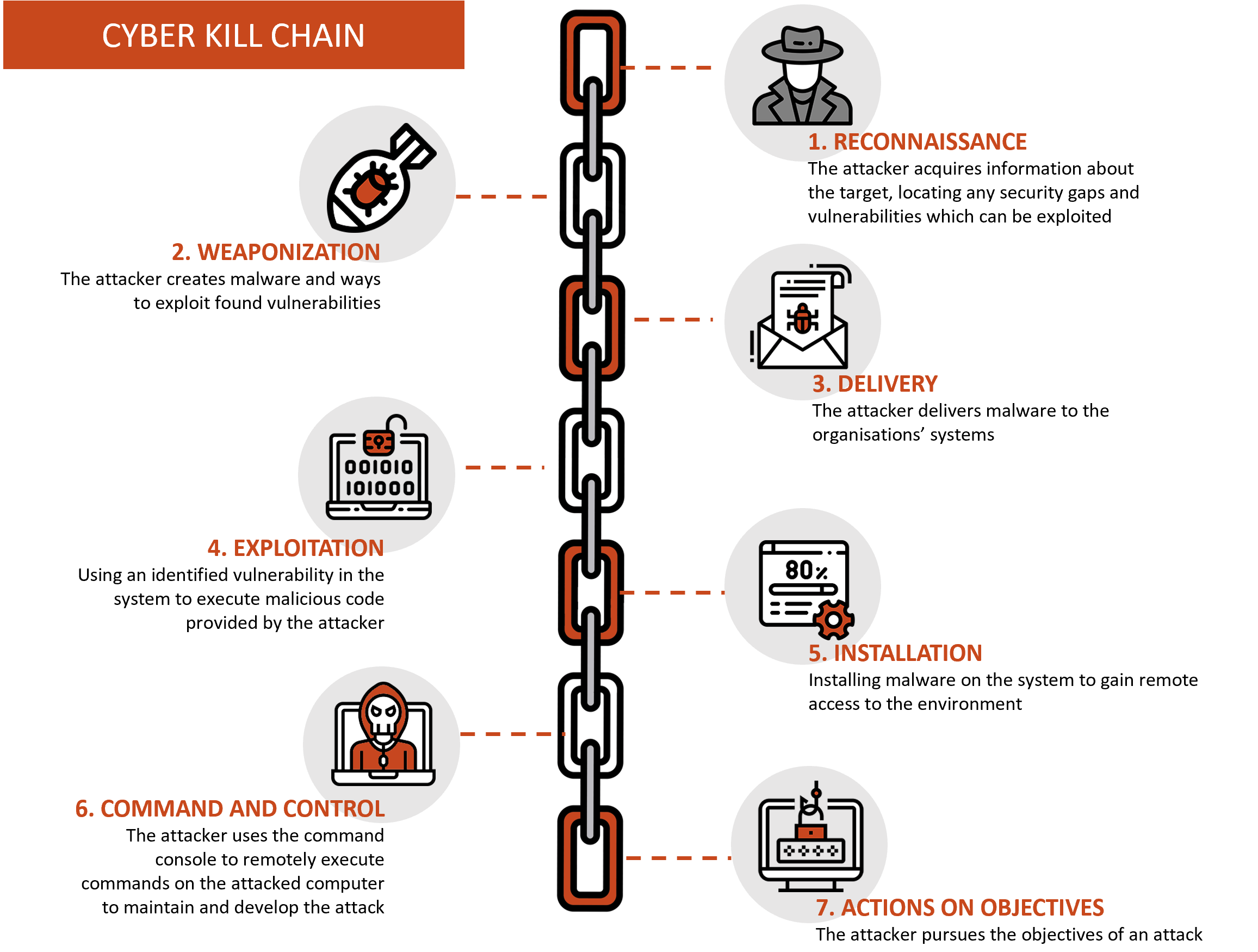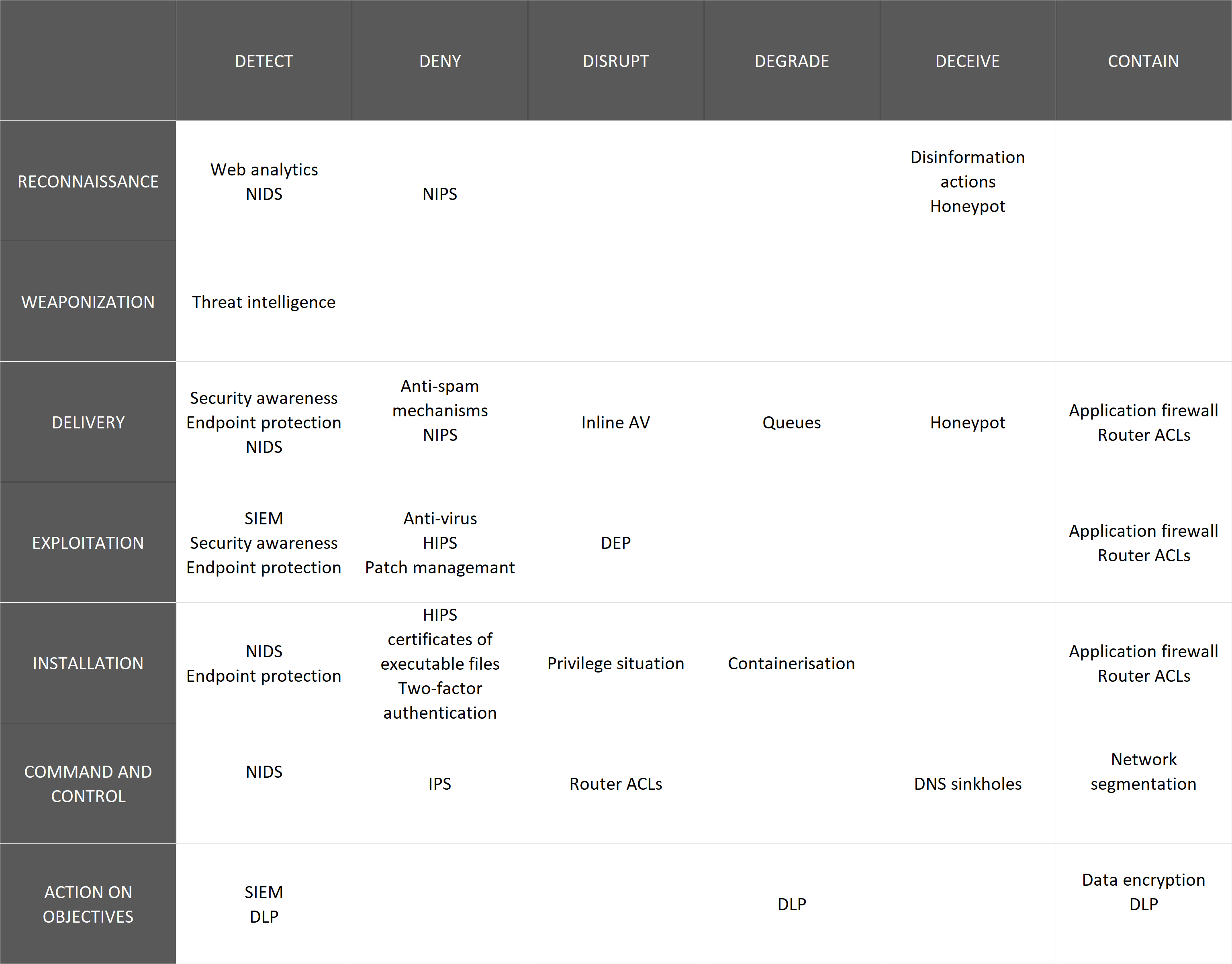Cyber Kill Chain – what is it and how to use it to stop advanced methods of attack?
Recently the number of cyberattacks has increased year on year. It is also estimated that the number of attacks conducted with the use of ransomware increases by 350%¹ each year. Additionally, the Covid19 pandemic has caused an increase in the number of malicious emails by 600%². An understanding of the characteristics of attacks and strategies used by attackers is one of the key ways of protection against potential attacks.
Cybersecurity experts have created a few models showing the characteristics of attacks. They have described the various stages of attacks as well as the methods and techniques used by attackers. The following article is an introduction to the Cyber Kill Chain model – the stages of the process and the methods of attack mitigation on each stage of that process.
In this article, we will discuss:
- what is the Cyber Kill Chain?
- where does the term originate?
- according to the Cyber Kill Chain framework, what are the stages of a cyber attack?
- what security measures can be put in place to protect you from each stage of a cyber attack?
- what are the ways for this framework to be used in practice?
- the faults of the Cyber Kill Chain model.
In subsequent articles, we will also introduce: the Diamond Model, the Mitre Att@ck and the ICS kill chain model, we will also discuss the specifics of using each of those models and compare their advantages and disadvantages.
What is the Cyber Kill Chain?
The Cyber Kill Chain is a model clearly illustrating the framework of a successful cyber attack. It sorts actions taken by attackers into systemised stages, from gathering information about a target, through preparing all necessary tools and delivering the malware, to finally completing the goal of an attack. The model can help us get a better understanding of various types of attacks, including data theft, advanced persistent attacks (ATPs), attacks conducted using malware and be more prepared to handle them when they occur. Thanks to a good understanding of the Cyber Kill Chain, IT security management teams can use strategies and technologies designed to break the chain of invasive actions and stop the attack.
Cyber Kill Chain- a military approach to attacks
The term „kill chain” was originally used by the military, in the context of describing stages of attacks. A particular military kill chain framework, called “F2T2EA”, consists of the following stages:
1. Find – identify the target,
2. Determine – determine the target’s location,
3. Route – monitor the target’s movement,
4. Target – choose an adequate measure to use on the target,
5. Implementation – use the chosen measure to conduct an attack,
6. Review – review the attack’s efficiency.
This integrated, complex process, described as a chain because its stages resemble the links of a chain (and breaking of those chains would put the process on halt) is an effective method of protection and prevention of attacks.
The Stages of a Cyber Kill Chain
In 2011, Lockheed Martin applied the structure of a military kill chain to information security, interpreting it as a method of conducting an attack on an information network. Martin created a chain with the following stages:
How the Cyber Kill Chain can help you protect against attacks
Reconnaissance
The attacker acquires all necessary information about the target with the use of either manual methods or automated scanners designed for mapping organizational structures, locating any security gaps and vulnerabilities which can be exploited. The attacker’s goal is to identify and investigate security systems such as: firewalls, intrusion prevention systems and authentication mechanisms. OSINT tools are often use in this instance in order to access necessary information.
Objective of defense: detection of attempts to scan or gather information by an attacker.
Method of defense:
- periodical analysis of the visibility of the information about the company as well as its employees online and in publicly available registers(np. e.g. Shodan) and taking corrective actions (e.g. deleting undesirable content),
- regularly checking logs to see who has accessed the company’s website,
- using tools designed to detect actions typical for the attacker to take during the reconnaissance phase of an attack, e.g. conducting network or domain scans.
Weaponization
Attackers use the information gathered during the reconnaissance phase to create malware and ways to exploit found vulnerabilities. Because almost all of the attacker’s actions are taken “on his side”, halting and them during this phase is essentially impossible. During this phase, it is recommended to focus on identifying vulnerabilities and strong points of each device and system and prepare for an attack. The identification of vulnerabilities allows us to determine which elements of our security could serve as a gateway for an attacker and should therefore be treated with particular attention.
Objective of defense: identification of vulnerabilities and methods of providing adequate security to key resources.
Methods of defense:
- identification and upkeep of up to date information about kept and protected resources,
- identification of vulnerabilities within your organization as well as hardening of key resources,
- monitoring and analysing new vulnerabilities and installing updates containing patches,
- using threat intelligence to recognise and prepare for possible new vulnerabilities.
Delivery
Attackers attempt to deliver malware to organisations’ systems or to exploit identified weaknesses. A popular way of delivering malware is through sending links or attachments using phishing techniques.
Aim of defence: to detect and prevent downloading malicious code.
Methods of defense:
- increasing the level of threat awareness by educating employees and associates,
- implementing additional security measures, including firewalls, anti-virus programs, sandboxes and other endpoint protection tools,
- use of anti-spam mechanisms,
- network traffic monitoring to identify and actively block threats based on the origin and content of packets.
Exploitation
Using an identified vulnerability in a system to execute malicious code provided by an attacker.
Aim of defense: preventing the execution of malicious software.
Methods of defence:
- using SIEM (Security Information and Event Management) software to investigate logs and perform analyses to identify suspicious activities,
- using endpoint protection tools such as EDR (endpoint detection & response),
- teaching users to recognise malware and respond appropriately,
- using threat intelligence solutions, supplying knowledge bases of devices providing protection against viruses, IPS or IDS.
Installation
Installing malware on a system to gain remote access to the environment.
Aim of defense: wdetecting an attacker in order to prevent him gaining access to managing operations.
Methods of defence:
- HIPS (Host-based Intrusion Prevention System) to warn or block a trial installation on common paths,
- periodic inspections of changes in the system’s configuration compared to the standard configuration (baseline),
- checking the certificates of all signed executable files,
- separation and segregation of rights in order to prevent an installation,
- two-factor authentication.
Command and control (C2)
An attacker uses the command console to remotely execute commands on the attacked computer to maintain and develop the attack.
Aim of defense: to detect and disrupt communication between the target and the attacker.
Methods of defence:
- requiring the use of internal proxy servers for all types of traffic (including http, DNS),
- DNS sinkholes (DNS server returning invalid domain names) and cache poisoning,
- passive monitoring of network traffic and archiving metadata on conversations between network components,
- network monitoring using NIDS (network Intrusion Detection System) to detect unusual activities.
Action on objectives
In the final stage, the attacker pursues the objectives of an attack, e.g.: leaking data (violation of data confidentiality), data modification (violation of data integrity) or system encryption (violation of data availability).
Aim of defense: stopping the attacker’s actions.
Methods of defence:
- monitoring database activity,
- immediate response of experts to alerts,
- creating a plan for security incident response,
- implementing crisis communication processes,
- processing sensitive data in separate ICT networks or using separate stations,
- using encryption methods for processed data (e.g. data carrier encryption, e-mail encryption),
- systematic backup on off-line media.
Methods of disrupting attacks
To interrupt the Cyber Kill Chain, the following types of defensive actions can be taken:
1. Detect – determine when and how the attacker performs a reconnaissance of an organisation or network,
2. Deny – stop the attack by making revealing sensitive information and unauthorized access impossible,
3. Disrupt – change or stop information flow or data leakage,
4. Degrade – limit the effectiveness and efficiency of the attack,
5. Deceive – disrupt an attack by misleading or misinforming the attacker,
6. Contain – limit the scope of an attack to particular segments of the network or organization.
Cyber Kill Chain Control Matrix
Knowledge of the kill chain stages, defensive actions and solutions which can be used against attackers, allows to create a Cyber Kill Chain Control Matrix. Its purpose is to identify the control mechanisms that the organisation has implemented as safeguards for each stage of an attack and to determine how they can contribute to disrupt, stop or eliminate a cyber attack.
An example of Cyber Kill Chain Control Matrix:
The presented matrix can be used as a template to identify resources and assign them roles in system protection, making it is easier to identify the stages in which our resources can provide accurate protection against an attack. This template can help identify which resources would be sufficient protection an attack and in which stages additional protection is needed.
Disadvantages of the classic Cyber Kill Chain model
Lockheed Martin’s Cyber Kill Chain model used as a risk assessment tool is not a perfect model. Its main disadvantage is that its methodology is based on network security and prevention of malware and aimed at reinforcing traditional defence strategies. Unfortunately, these are not the only vectors of attacks. Because traditional kill chains in cyberspace are not suitable for handling internal threats, e.g. one caused by employees of a given company, there is a need to develop separate strategies to deal with attackers coming from within the organisations. Additionally, the first stages taking place outside the defended network a disadvantage to the attacked system, making the process of identifying or defending against attackers’ actions very challenging in these stages.
Applying the Cyber Kill Chain
In the 9 years since the creation of the Cyber Kill Chain, the technology and methods of conducting attacks have evolved significantly and new attack vectors and ways of utilising them have emerged. Now, the attackers tend to skip the individual stages of this model, adding new steps or repeating them, although the Cyber Kill Chain remains widely used.
The model allows to determine the level of security as well as to prevent and significantly reduce the effects of a potential attack.
Cyber Kill Chain is one of several methods of understanding the course of cyber attacks. Over the past few years, a number of other detailed models of hostile actions have emerged.
In our next few articles, we will present the diamond model, Mitre Att@ck and the kill chain model for ICS, discuss their use and compare the pros and cons of all the described models.
Sources:
1. Cyber Security Statistics for 2019
2. ONZ: podczas pandemii liczba złośliwych e-maili wzrosła o 600 proc.
3. Gaining the Advantage – Applying Cyber Kill Chain® Methodology to Network Defense
4. How the Cyber Kill Chain can help you protect against attacks




0 Comments